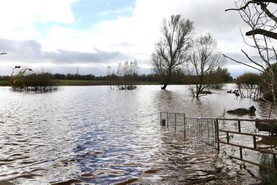From boom to gloom: Having experienced the prospect of its best yields for many years, the south of the country is being beaten by storms and heavy rain, resulting in 15-20% field losses from 10 days ago. Crops are beaten down, heads are shaken off and grain shedding is very visible.
Elsewhere the situation is less bad, but yield expectation was lower. Yields still remain reasonable for those who managed to get some cutting done but quality is being hit, especially specific weight in spring barley, and fusarium has become increasingly visible. Skinning remains an issue but it may not have gotten any worse so far and there are a range of issues that are now causing rejection for malting.
It may be of interest to note that we also had very broken weather at this time last year and that it was this week when things picked up. But in the meantime, we see crops turning black, straw beaten down, visible sprouting, and now fusarium is increasingly evident.
The challenges: Estimates suggest over 50% of the harvest has been cut to date but that is variable. With nearly half the harvest still to cut, don’t risk getting bogged with a combine when we get going again – leave dodgy patches and come back. Ensure that all four-wheel-drive units are working or fit duals if there is even a chance that you may have wet patches. Follow the advice on pages 38-39 for keeping the combine moving and to help minimise soil damage. Some crops are beaten into the ground by the storms so having risers fitted may be of some use. While the crops are tossed in every direction, lifters may still help as the heads are down in bunches. Skint grains remain a concern so be as gentle as you can with the drum and concave – possibly easier where crops are very ripe.
Oilseed rape: Planting should be completed as soon as possible as we move into September. Stay with recommended seed rates for another week.
Seedbed fertiliser, and especially organic manures, can be a real help to drive backend growth if you can get time to get it on. Alternatively, consider something like a 50kg bag or two per acre of 10:10:20 or 18:6:12 – P and K can be very beneficial on soils with low to moderate indices.
Emergence should be fast so watch for signs of flea beetle damage. This will appear as little ‘shot-holes’ on the cotyledon and can kill the seedling if it gets bad enough. We tend not to have as big a problem as other countries because our temperatures are somewhat lower and we do not have that density of oilseed rape crops.
The bigger worry here is the laying of eggs at the base of the plant resulting in larvae causing severe damage in the stems over winter and into spring.
Insecticide should be considered to halt the build-up if you see more than a few holes on about 20% of plants. Early crops are most at risk. Insecticide options include Karate Zeon, Karis, Lambda, Markate 50, Ninja, and Sparviero.
Get residual herbicides like Katamaran Turbo applied post-sowing if possible.






 This is a subscriber-only article
This is a subscriber-only article










SHARING OPTIONS: